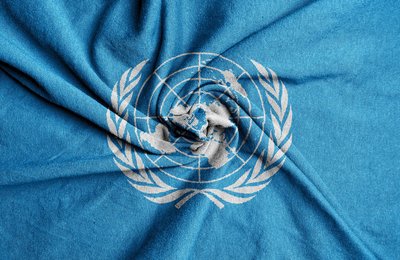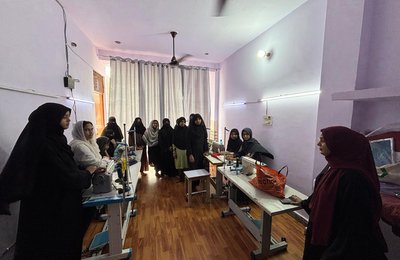 People have been fleeing the violence in Aden and which has severe shortages of all essential items, including water. Image credit: brunobiasutto.
People have been fleeing the violence in Aden and which has severe shortages of all essential items, including water. Image credit: brunobiasutto.The conflict which has broken out in Yemen will be as long and awful as any war can be. While political and even military internal struggles are hardly a novelty in Yemen, a new element of international 'proxy’ war makes this one worse, and reminiscent of the Lebanese civil war in the 1970s-80s.
Why is this the outcome of the 2011 revolutionary uprisings, which sought economic development, justice, dignity and the end of kleptocracy? The outbreak of full-scale war, including foreign parties, is an entirely unprecedented phenomenon in Yemen, which will affect the country and the region for years to come. Indeed, while Saudi Arabian involvement in Yemeni affairs is longstanding, this is the first time the country has taken the initiative to launch a major military attack.
Decisive Storm and Yemenis
The GCC/Saudi intervention was prompted by the immediate threat of a complete Houthi/Saleh take-over of the country, and the prospect of having a regime closely allied to Hizbollah and Iran on Saudi Arabia’s southern border. While Iran manifested only marginal interest in Yemen – until recently giving the Houthis no more than verbal support – it has now seriously increased its diplomatic and material backing, creating the ‘proxy’ war situation which previously was largely absent from Yemeni political and military discourse.
 Migrants fleeing Yemen have been arriving in Somalia, pictured. Image credit: IOM.
Migrants fleeing Yemen have been arriving in Somalia, pictured. Image credit: IOM.In the middle of this, the Yemeni people are trapped. Incredibly, Yemenis are now seeking refuge in Somalia, with more than 500 people killed and 1,800 wounded at home, to date. Food and fuel shortages are worsening, water is short everywhere and the Houthis are cutting supplies to the areas of their enemies: Aden has been without water for some time now. House to house fighting in Aden has led to mass escapes by sea to Buraiqa, on the other side of the Aden bay, and massive destruction of housing and social and communications infrastructure. Other cities like Taiz are also currently the focus of fighting between factions, whereas Sana’a and other areas ‘under Houthi/Saleh control’ are ‘only’ subjected to air strikes.
Furthermore, the country is effectively under blockade, with its airports destroyed and sea routes blockaded by the alliance of anti-Houthi/Saleh forces. And the few countries which used to allow Yemenis in without visas – Egypt in particular – have withdrawn this facility, leaving 4,000 Yemenis stranded around the region.
Who is to blame?
Yemen has descended into violence as the consequence of a range of political forces. Principally, the Yemeni political class has completely failed to address the country’s fundamental problems, and has instead spent the last few decades either enriching itself or fighting over internal disputes.
In the long run, Yemen’s international partners of all hues have played a role in this debacle. The ‘development' policies which have been promoted and indeed, imposed, on Yemen have contributed to the worsening of poverty and the disintegration of social cohesion throughout the country, by weakening the state’s ability to provide services. This has allowed the rise of extremist movements, particularly among unemployed youth.
The situation on the ground
It is easy to start wars and hard to end them. The current intervention has destroyed a lot of the country’s military hardware, but it has failed to prevent the Saleh and Houthi forces from taking control of large areas of territory, or indeed expanding their area of influence.
 The IOM has organised evacuation flights from Yemen. Image credit: IOM.
The IOM has organised evacuation flights from Yemen. Image credit: IOM.The so-called Al Qaeda takeover of Mukalla is an exact replica of the manner in which Ja’ar and Zinjibar were taken over by Ansar al Shari’a, an Al Qaeda clone, in 2011. In both of these examples, for ‘Al Qaeda’, ‘Saleh irregular forces’ is not far off the mark. What is described as AQAP in the international media often refers to little more than local community resistance supported by a few trained extremists. In the last month, at least, one of the earlier systematic forms of disinformation of international media has been corrected and now, rather than talk of the Houthis, most media more correctly refer to the Houthi/Saleh forces. Ex-president Saleh, wherever he is, is doing what he promised: destroying as much as he possibly can, on the principle of après moi le déluge.
What now?
This war, like so many others, does not serve the interests of the majority of the population, who seek development, a means of earning an income and of living healthy and happy lives. The war in Yemen serves the interests of the wealthy: the leaders of the main factions, who have taken control of the country’s limited wealth in past decades. Arms traders are also laughing all the way to the bank: at long last the vast supplies of extremely sophisticated and expensive weapons sold to Saudi Arabia are being used, thus ensuring further profits for the major manufacturers of munitions who will be able to sell replacements.
Decisive Storm or Restoring Hope will continue: airstrikes will soon become counter-productive, with the diverse population on the ground ensuring ordinary inhabitants are victims just as much as military targets. In addition, the Houthis are already putting their prisoners in or near weapons stores. Will those stores remain targets?
The beautiful Yemen many of us know and miss so deeply is being destroyed, and its millions of generous and wonderful people are being driven beyond endurance. Those of us outside should do whatever we can to bring about an end to the killing and destruction and help the return to a political dialogue, ideally a more effective one involving all forces in the country.
Young democrats in Yemen will have time to reflect on their ideas. It will be at least a decade before they have any chance of putting them into practice.
This is an edited and updated version of an article which first appeared on Open Democracy. It is republished here with the author’s consent under a Creative Commons 3.0 licence.
Insight on Conflict will soon be launching a new section on Yemen, with updates and profiles of local peacebuilding work in the country. Check back to find out more.






